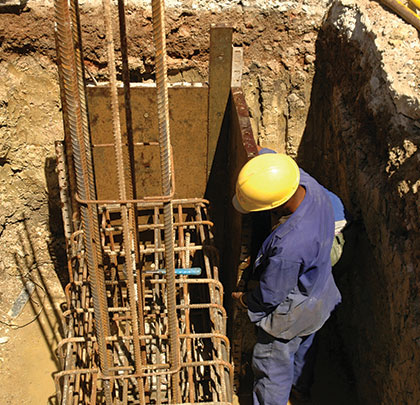In a recent decision, the federal Occupational Safety & Health Review Commission (OSHRC) issued a decision reversing a judge’s ruling that had decreased the severity of a citation, and restored the “willful” violation findings against the employer. OSHRC also increased the civil penalties in the case for all violations from $36,000 (in the judge’s order) to $87,000. The ruling in Secretary of Labor v. Stark Excavating, Inc. on November 3, 2014, constitutes binding precedent and was a unanimous decision by the three OSHRC commissioners.
THE CASE
The employer is an excavation and paving company based in Illinois. It was cited for a serious eyewear violation under 29 CFR 1926.102(a)(2), two willful excavation cave-in protection violations under 1926.652(a)(1), and a repeat excavation spoil piles violation under 1926.651(j)(2). In the initial trial, ALJ Augustine affirmed all citations but recharacterized the two cave-in citations from willful to serious. OSHA appealed to the Commission, which vacated the eyewear citation and affirmed the spoils pile citation as issued. The majority of the decision focused on the two modified (former willful) citations, which involved two different Stark worksites.
The first cave-in citation, at the Champlain, Illinois, worksite, to which Stark had raised an affirmative defense of “unpreventable employee misconduct” (UEM), was found to be a violation but was left as modified to “serious” by the OSHRC. In that situation, the superintendent, who was the designated “competent person,” had left the worksite while the crew was installing pipe. After he departed, the crew found two utility lines crossing the excavation and stopped using the trench box because it would not fit between the utility line and the wall. While his original soil assessment had been “type B” he “eyeballed” this new area and determined it was more stable “type A” soil and so allowed them to continue without the box in place.
THE ISSUE
The Commission disagreed with the UEM defense. While it was undisputed that Stark had written rules addressing the violative condition, and it communicated its rules to employees and supervisors, the judge found that the supervisors did not effectively enforce the rules because they gave oral reprimands instead of written “safety tickets” … and the fact that the same conditions were found at two separate worksites also worked against the employer.
Oral warnings may be adequate, but only in rare cases “where an employer has a long, near-unblemished safety and health history” which can show that the employer effectively enforces its work rules. However, for this citation, the OSHRC agreed that there was not the requisite state of mind for a willful violation. There was adequate training provided to crew and supervisors, and no evidence that there was “deliberate disregard” for the OSHA requirements, because the supervisor had done a soil analysis, prepared an excavation report, and required use of a trench box prior to his departure from the worksite.
The company did not fare as well on the second willful violation, issued for lack of cave-in protection at the Peoria, Illinois, worksite. Again, Stark raised the UEM defense and, again, it failed. OSHA had appealed the reduction in negligence because the record showed that the Peoria foreman exhibited plain indifference to employee safety and deliberately disregarded the requirements of OSHA’s excavation standard.
THE OUTCOME
OSHRC distinguishes between mere negligence and willfulness, in that willfulness is characterized by an intentional, knowing failure to comply with a legal duty. This is contrasted with a non-willful violation being marked by a good faith, if mistaken, belief that the condition or action is in conformity with OSHA requirements. The willful violation state of mind is evident where the employer was either actually aware, at the time of the violative act, that it was unlawful, or possessed a state of mind such that, if it were informed of the standard, it would not care.
In short, the hallmark of a willful violation is the employer’s state of mind at the time of the violation: an intentional, knowing, or voluntary disregard for the requirements of the OSH Act, or a plain indifference to employee safety, can carry penalties of up to $70,000 per violation. In the case of a fatality (which was not the situation in Stark), willful violations can also trigger criminal prosecutions against agents of management.
The Commission ruled that the Peoria cave-in violation should be restored to a willful classification with heightened penalty. The evidence showed that the foreman knew the excavation walls were not properly sloped when the laborer was permitted to enter the 8-foot-deep trench that had type B soil, and no trench box was used. He also had not completed his daily report as required. As the OSHRC observed, “actual knowledge and deliberate avoidance of knowledge are the same thing … behaving like an ostrich supports an inference of actual knowledge.” Conscious disregard was established by showing that the foreman was the competent person and knew the condition violated OSHA standards and still sent employees into the trench. ■
About The Author
Adele L. Abrams, Esq., CMSP, is an attorney and safety professional who is president of the Law Office of Adele L. Abrams PC, a ten-attorney firm that represents employees in OSHA and MSHA matters nationwide. The firm also provides occupational safety and health consultation, training, and auditing services. For more information, visit www.safety-law.com.
Modern Contractor Solutions, January 2015
Did you enjoy this article?
Subscribe to the FREE Digital Edition of Modern Contractor Solutions Magazine!


